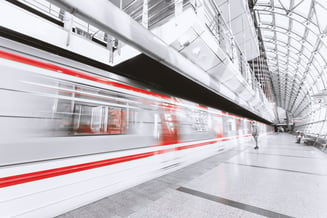
Top 6 Innovations that are Driving the Rail Industry
Just one bad experience on a train or at the station can shape a passenger’s impression of the rail service and put them off using that service again....
Read more
4 minute read | 02/01/2020

In Q4 of 2023, rail passenger journeys saw a 20% increase compared to the same period in 2022, as more people returned to offices and leisure travel picked up post-pandemic. Passenger revenue and average journey lengths also continue to rise. This is thanks to Train Operating Companies (TOCs) actively embracing innovation and emerging technologies to modernise services and enhance the overall travel experience. Learn More About WiFi Innovation for Transport
Expanding on the initial triumphs of augmented reality (AR) within the rail industry. The emergence of extended reality (XR) technologies, blending AR, virtual reality (VR), and mixed reality, has gained significant traction. Through immersive XR training simulations, maintenance personnel can hone their skills by practicing intricate procedures in a safe virtual setting, ultimately enhancing proficiency and minimizing service interruptions.
Enhancing the passenger experience remains a top priority for TOCs. Innovations such as contactless ticketing, real-time journey planning apps and personalised travel assistance powered by artificial intelligence, aim to create a seamless and hassle-free journey from start to finish.
WiFi plays an important part in improving the passenger experience. As train expenses continue to climb, data reveals that 22% of travellers express discontent with the affordability of their journey, while 24% are frustrated with the inconsistent internet connectivity. This highlights the importance of WiFi from a passenger standpoint. However, WiFi isn't only beneficial for the passenger, TOCs are provided a return on investment in a multitude of ways.
The government has told rail companies to stop providing WiFi, unless they can demonstrate its business case. With SPARK TSL’s WiFi service, this won’t be a problem. Just look at how we transformed the passenger journey for Chiltern Railways by Arriva.
The integration of Internet of Things (IoT) sensors and advanced analytics has paved the way for predictive maintenance strategies in the rail industry. Digital twins, which are virtual replicas of physical assets, allow for real-time monitoring, simulations and optimisation of maintenance schedules. Therefore, reducing downtime and extending asset lifespan.
While still in the early stages, autonomous rail operations have gained significant interest and investment. Automated train control systems, combined with advanced sensor arrays and robust communication networks, aim to improve safety, efficiency and operational flexibility. Several pilot projects for autonomous freight and passenger rail services are currently underway worldwide.
With growing emphasis on sustainability and environmental responsibility, the rail industry has accelerated the adoption of eco-friendly technologies. These include renewable energy sources for powering infrastructure, energy-efficient rolling stock and smart grid integration for optimised energy management.
Chiltern Railways, a long-standing SPARK TSL customer, has won the 'Sustainable Development' category at the National Rail Awards in 2019 after their ‘Clean Air Zones’ campaign to help tackle pollution at Marylebone Station. They also won the Innovative Rolling Stock award at Spotlight Rail Awards in 2024 for their use of recycled vegetable oil powered trains.
Additionally, intelligent traffic management systems are being deployed to optimise routes and reduce congestion, further minimising environmental impact.
The integration of cutting-edge drone technology, along with advanced high-resolution cameras, thermal imaging, and LiDAR sensors, has revolutionized the way rail infrastructure is inspected and monitored. These innovative systems have the ability to swiftly identify potential issues such as track defects, encroaching vegetation, or structural damage, enabling proactive maintenance and reducing service disruptions to a minimum.
As the rail industry continues to evolve, TOCs that successfully embrace these innovations and prioritise passenger satisfaction will gain a competitive advantage in attracting and retaining customers in an increasingly connected and digitalised world.
Uncover more about the possibilities of WiFi for the rail sector with our Transport Brochure.
Alice graduated from Plymouth University with an English Literature and Creative Writing degree. She joined SPARK TSL in June 2022 as a Content Specialist in the Marketing department. Alice creatively champions the SPARK Solution, advocating for its ability to alleviate pressure on the NHS.
More articles by the author

Just one bad experience on a train or at the station can shape a passenger’s impression of the rail service and put them off using that service again....
Read more

Transport data collections have been carried out by the transportation sector to measure everything from traffic buildups and road surfaces to the condition of...
Read more

How to Stay Safe on the Internet The age-old saying, "If something seems too good to be true, it probably is," has previously served as a reasonable defence...
Read more